(Photo by John Adams/Icon Sportswire)
*Swanson went 0-4 last night vs Cincinnati, so the following information is slightly skewed but bears no weight on the article premise.
It seems like almost everything Atlanta Braves‘ starting shortstop and former number one overall pick Dansby Swanson hits turns into a success. As of April 23rd, Swanson is third overall in BABIP out of all qualified hitters. Really, none of the following figures is sustainable long-term. In fact, you can expect most to drop at 100 points lower than they are now.
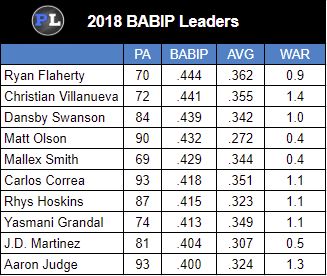
To further elaborate on his raw data (I saw ‘raw’ because it’s too early to make assertions of validity), Swanson has had just four games out of 19 where he didn’t accumulate at least one hit. In those four games, he never reached base.
To start, have a look at Swanson’s xStats and Statcast data, just to see how far over his head he’s playing. Note that the Statcast xBA is formed by taking both of the average Exit Velocity (EV) and Launch Angle (LA), then using those numbers to produce a batting average under those exact conditions; more of a frame of reference for how rich Swanson’s contact has been. You can also glean that his similar metrics also tell a different story in early 2018.

Looking at his rolling exit velocity, we see general steadiness up until about 250 batted balls. After which we see a bubble, with another one (potentially) starting to form at the very end of the chart. I’ll look at how much of a drop in performance will occur should it follow the predicted pattern of another burst bubble.
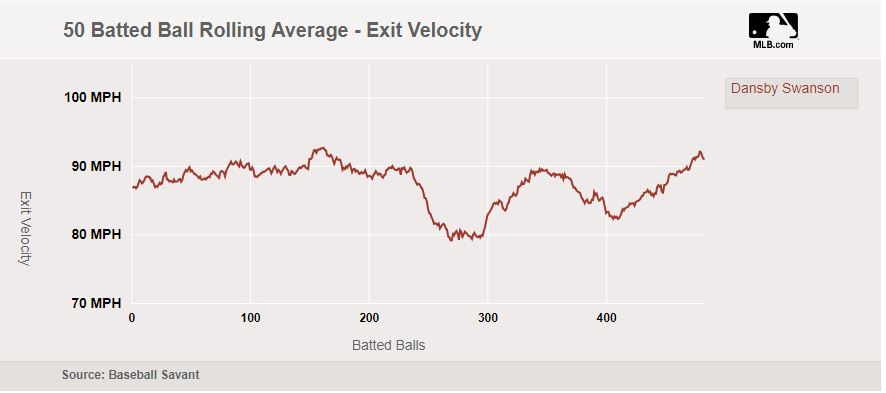
Using the standard deviation of a bit over 8MPH, let’s check the fluctuations in batting average. When Swanson is on the low end, 79 MPH up to 87 MPH, his batting average is .175. From 88 MPH to 95 MPH, the high-end of where he’s generally hitting, you get Swanson at .571. Swanson has shown he can maintain his average EV but the recent trend is cause for alarm.
Next, we look at how he’s getting on base. Swanson has been a low-walk guy and this year has seen his rate fall to just under 7%. Furthermore, his OPB isn’t that far removed from his batting average; a 45 point difference, with the league average being about a 70 point spread.
Taking the last three years of walk and swing data, I found qualified hitters average an 8.4% walk rate and a 46.7% swing rate. As no surprise, there is a decent relationship between the two metrics as you’ll see below. Swanson is marked with a red ‘x’ and the chart average is marked with a black ‘x’.
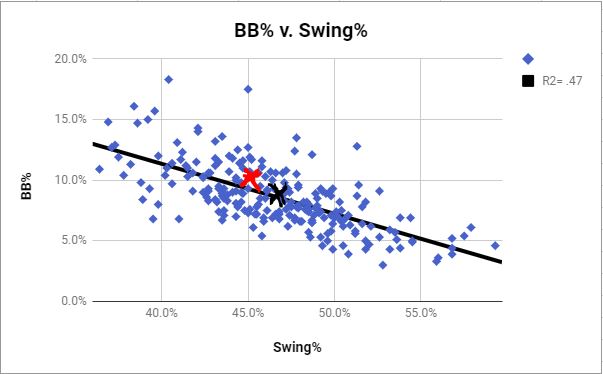
Despite the fact that there is almost no correlation between batting average and walk rate, you’ll eventually get fewer pitches to hit as pitchers would assume you’ll swing a lot more; the chart above proves that. Swanson can’t keep relying on his bat, he’s got to lean a little more on his eye and draw some more walks; mainly because of the implications of a way-too-high BABIP. As a result of a continually low walk rate, his on-base production faces a significant drop should the hits stop coming.
We learned that almost half of Swanson’s batted ball events are ground balls. The first question is can we reasonably consider his high BABIP a direct result of his groundball rate? Again, I took all qualified hitters from the present day back to 2015 and got an average BABIP of .304 and an average GB% of 43.8%; Swanson’s current mark is 46.6%. Take a look at the scatterplot below; the black ‘x’ representing the average. Seeing there is zero correlation between the two, no sensible assumption can project where Swanson could expect his BABIP to fall if he continues hitting groundballs much more than fly balls and line drives.
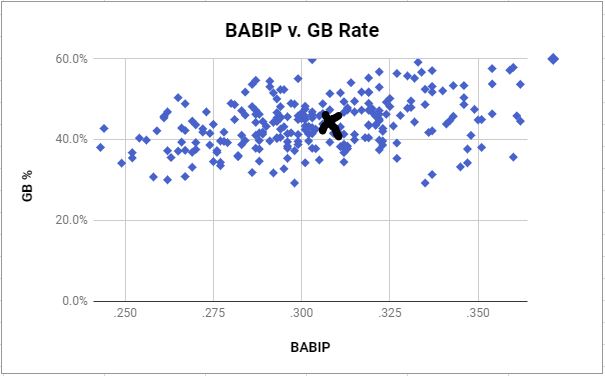
What about his plate discipline? Nothing else stands out when looking at his current contact info; not line drives, fly balls, hard hit rate, etc. All are right within Swanson’s short career average. We can be confident in those metrics because most all of Swanson’s numbers have passed the point of sample size.
Have a look at where Swanson’s 2018 contact has fallen in relation to the strike zone. He’s creating all of his BBE in or very close to the strike zone, which is a really good thing.
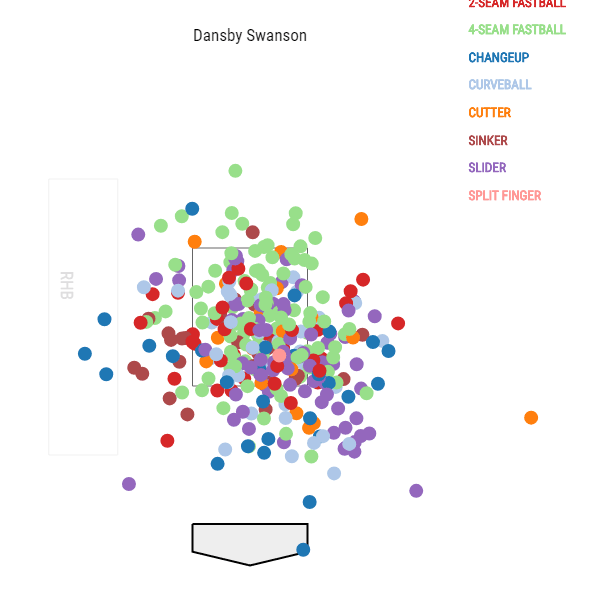
Here we have both his swing and contact rates, accounting for all games played compared to the league average.
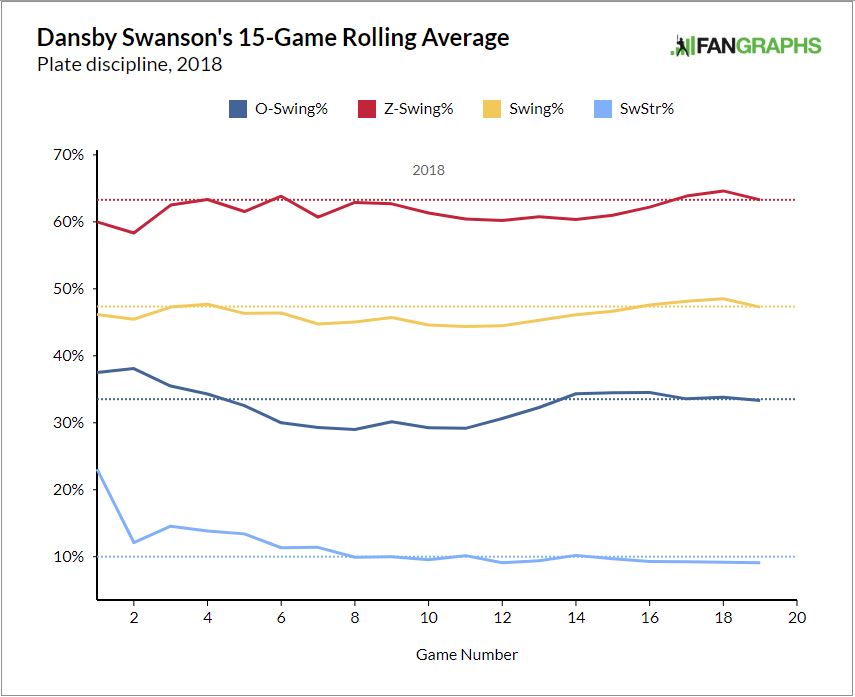
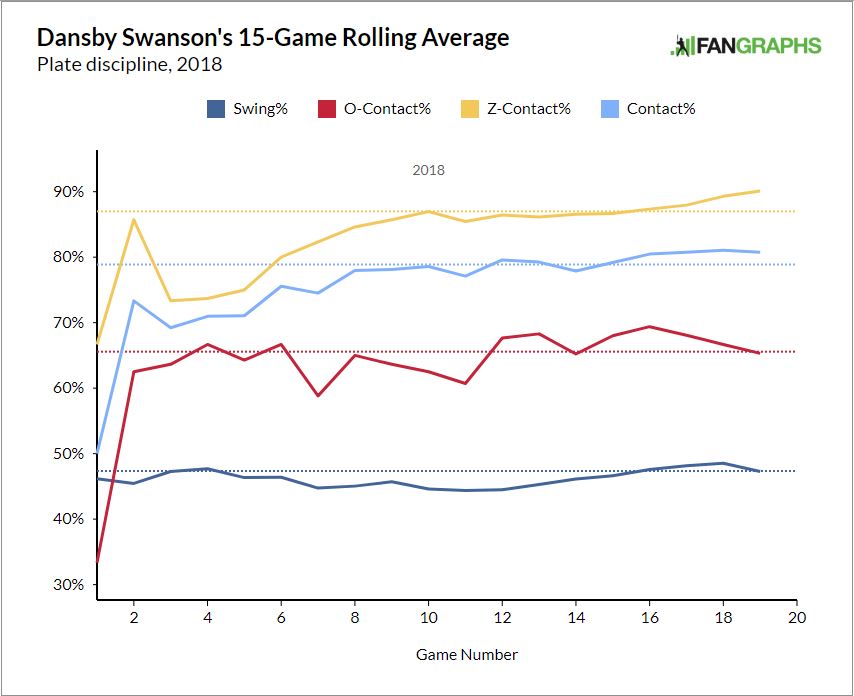
We see a very steady trend, the first week or so of games notwithstanding. Some dips here and there but nothing long-term (3-5 games). However, somewhere between games 6 and 12, you notice a fair drop in O-Swing rate along with several bubbles of the variance in his O-Contact. His batting average during those (slightly more) disciplined plate appearances? .255. That alone makes it hard to think his eye has gotten better or tied to his early hitting success.
An interesting thing to note when looking at his contact trend is you see that the last couple games have Swanson making his best zone contact or contact in general; it has been slowly trending upward since his 12th game.
Much like in the past, pitchers are attacking Swanson low and away this year; almost a third of the pitches Swanson faces land there. And this is occurring for good reason; his batting average is .090 in that zone and his whiffs per swing sit at 56%. It would make sense for Swanson to take a few more pitches knowing where the tendency is to spot the pitch. More on that in a second.
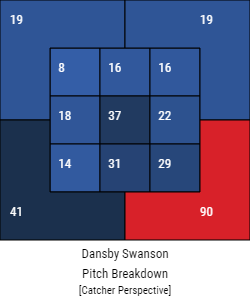
On average, he’s averaging 4.1 pitches per at-bat which sets him at 26th overall in 2018 pitches per at-bat. And while his swing rate isn’t any sort of outlier, he’s also seeing nearly 70% of first-pitch strikes. That’s relevant because he’s swung at the first pitch just six times and accumulated three hits (single, double, triple). But still, no proof of a reason for that elevated BABIP of his.
It would do Swanson a disservice to himself if he didn’t try to swing at the first pitch more often considering how many strikes he sees on that pitch. On the flip side, to paraphrase Paul DePodesta, you don’t want to become predictable. There is a delicate balance but Swanson should be aware of how he’s getting his (arguably) best pitch to hit, which is occurring 10% more than league average.
According to this 2014 Grantland article concerning the first-pitch strike, batting average on a 0-0 count is the highest of any with a .342 batting average. It should be recognized that, for his career, Swanson hits almost 100 points lower; it would be pertinent if he wasn’t looking like a completely different hitter this year.
Swanson will just have to remain an enigma for now in the sense of how great he’ll end up being. After a completely underwhelming start to a promising career, Swanson has done a 180. It would be comforting to Braves fans if we knew for certain that he’ll continue to perform at a high level, regardless of his impending BABIP crash. It’s difficult to say how much it will actually bring the rest of his production down. This link to Swanson’s scouting report provides some perspective on what we can expect. It might be that Swanson has already turned the corner and will become a star; he’s got all the potential for that.
Using the ratio of BABIP drop to batting average, and assuming a steady amount of production in line with his current performance (strikeouts, walks, etc) without many deep slumps, at this point I would project Swanson to hit around .288 this year. This is based on his historical BABIP (which is not yet considered stable) and calibrating it to league average.
Justifiably a number one overall pick and the next in a line of budding Braves stars? Not just yet.

Interesting article on Swanson. I drafted Arcia late in our points league. Now have a chance to pick up Mets youngster Rosario for the same price. Who would you rather have for the next couple of years? Arcia or Rosario.